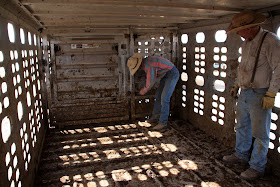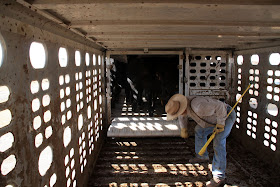This story has been floating around this week, and my whole family gets a kick out of it, hope you do to.
When I was around six or seven years old, we would go to the Rocky Point Grazing Association, which you can read about here. Every fall we had to sort our yearlings multiple ways prior to shipping out. You know, get the neighbors out, sort steers from heifers, sort of any gimps or dinks, etc...
By this time I was an exceptional gate runner (or certainly thought I was). Running a gate means you're responsible for opening and closing it in time with the animals that need to be sorted into your pen. Sounds simple, and sometimes is, but it can also be a very fast moving, complex job at times. There are moments it will test your grit too as a little kid, when an alley of 900-plus pound yearlings are bearing down on you, and you're responsible for running out in front of them, holding a gate a little stick for protection, just to sort one into your pen.
Anyway, I was assigned a gate to run. This guy named Frank, who is also a member of the grazing association, apparently thought a little three and a half foot tall, probably 50 lb, girl with wild, almost white, blond hair, might need help. Poor guy.
Frank had one of his hands wrapped, because he had injured it in some way. He also always has a great big cigar in his mouth that he chews on and rolls around while working cattle.
He props his wrapped hand on my gate, which immediately causes a smalle tingle of concern to go through me. My dad must have been another gate across the alley, because he watched all this, and didn't tell Frank I was capable, which also caused a tingle of irritation to go through my little body.
Down the alley come a bunch of yearlings, and my uncle starts calling out names as to where they needed to go. There's one for my pen, and Frank moves too slow and the yearling blows by our gate. Up goes my irritation level, especially as I get a less than patient remark about missing the steer.
A little additional information: My father and Uncle weren't patient when we were little kids, and I was the first born of my generation. We also ran a big operation at the time, and as they each had kids, we were expected to help at young ages. It was great for all of us, and their high expectations of all of us kids, and limited patience with us when we messed up, is why I could do things like run a gate like an adult at six or seven. It also meant that I too had very little patience with anyone who didn't get it right the first time around.
I don't remember this, but suspect my father was laughing at my prediciment right about here (we have quite the sense of humor in my family). My uncle, who couldn't see anything, but knew I was missing yearlings, wasn't laughing at all.
We get that worked out, and down the alley comes another draft, and again Frank is too slow in "helping" me get my gate open. This time I probably got yelled at, which will really set you into motion on our place as a little kid. It also caused my temper to spike, high up into the red.
Third time, here they come down the alley. My uncle yells my name, and I swing that gate out hard and fast, and smash Frank's hand between the gate and pipe it latches too.
My dad will be laughing so hard at this point he can hardly add that upon having his hand smashed by a little girl, Frank almost swallows, and chokes on, his big cigar.
The yearling goes where it's supposed to, and Frank gathers his composure and heads off to another part of the correl. I have no more issues with sorting that day, and don't get yelled at anymore.
Like I said, poor guy.








































